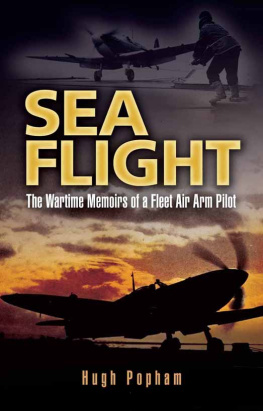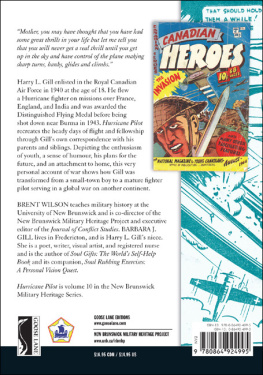The Author
Hugh Popham was descended from a distinguished family of naval men his most illustrious forebear established the Popham code that was used at the battle of Trafalgar. He wrote widely on naval matters after the War and was also a published poet and the editor of Erskine Childers sailing logs. He died in 1996.
SEA FLIGHT
THE WARTIME MEMOIRS
OF A FLEET AIR ARM PILOT
HUGH POPHAM
New Introduction by David Hobbs

Copyright Hugh Popham 1954
Introduction copyright David Hobbs 2010
This edition first published in Great Britain in 2010 by
Seaforth Publishing,
Pen & Sword Books Ltd,
47 Church Street,
Barnsley S70 2AS
British Library Cataloguing in Publication Data
A catalogue record for this book is available from the British Library
ISBN 978 1 84832 055 0
First published by William Kimber and Co Ltd, London, in 1954
All rights reserved. No part of this publication may be reproduced or transmitted
in any form or by any means, electronic or mechanical, including photocopying,
recording, or any information storage and retrieval system, without prior permission
in writing of both the copyright owner and the above publisher.
The right of Hugh Popham to be identified as the author of this work has been asserted
by him in accordance with the Copyright, Designs and Patents Act 1988.
Printed and bound by the MPG Books Group, UK
CONTENTS
DEDICATION
To those who are not mentioned in the following pages,
and to those who are, I make whatever
apology is fitting. To all of
them I dedicate
this book
New Introduction
T HIS wonderful memoir was the first account by a wartime naval pilot of his experiences flying fighters from the decks of aircraft carriers, and the authors remarkable powers of observation and gifted style of writing allowed him to describe his unique perspective with particular clarity and humour. Many have followed it but none have matched its ability to draw the reader into the events as they unfold. I can trace my own aspiration to become a pilot in the Royal Navy from the first time that I read this book.
Hugh Popham was studying law at Cambridge when he volunteered to become one of the early RNVR (Air) officers in 1939. He joined the Royal Navys Fleet Air Arm at a time when it had only four hundred front-line pilots and it had only double that number when he joined his first squadron in September 1941. He was a member of the first pilots course to be trained by the Empire Air Training Scheme in Canada and he was one of the first to be taught to fly Sea Hurricanes at the fighter pilots school at RNAS Yeovilton. This was the Navys most potent fighter in 1941 but there were only thirty-four of them in front-line service.
The Royal Navy had finally resumed full control of its carrier-borne aircraft in May 1939 after the failure of dual control, instigated in 1918. During that period, the RN had been responsible for operations at sea with the RAF overseeing administration, procurement and training ashore. Hughs instructors at RNAS Yeovilton were the survivors of the pre-war generation who had fought the early campaigns in Norway and the Mediterranean and who had seen their colleagues shot down in aircraft that were both obsolescent and out-numbered, fighting a new form of naval warfare. At first, the RNVR officers were the new boys, trained in numbers that filled the gaps in the pre-war squadrons. Within four years the Fleet Air Arm expanded tenfold, by far the greater number of the 4,000 pilots in the front line squadrons being temporary officers from Britain, New Zealand, Canada, Australia and South Africa. Few of them had any previous naval experience and their training with the RAF and in Canada left little time for them to assimilate a wider knowledge of ships routines and the way in which the Navy was organised. The need to learn new techniques was not confined to the young reservists, however, and senior officers appointed in command of aircraft carriers found themselves having to find new ways of understanding and leading the young men who had quickly become the experts in the new tactics of a very different form of naval warfare.
Pophams story is told with exceptional clarity as he describes his progress from initial training at HMS St Vincent in Gosport, through flying training to life in 880 Naval Air Squadron, a fighter unit embarked in a fleet carrier. His eye for detail and skill as a writer allows him to bring situations and events to life and draw the reader into the story as if he were there. His loyalties gradually expand from the friends on his course, his squadron and ultimately to his ships, especially HMS Indomitable, as he comes to terms with service life. It is a very human story in which he reveals both excitement and his innermost doubts, especially when friends and those around him are killed. His first book, an anthology of poems entitled Against the Lightning was written while he was serving in Indomitable.
Sea Flight is helped by its finite structure, beginning with basic naval training as ratings, followed by flying training where we feel the excitement he felt as each stage was successfully completed and share his trepidation before his first deck landing. Sea-time in four aircraft carriers makes up the middle of the story which ends when he was appointed to a desk at the Admiralty.
He describes people with such shrewdness and insight that we feel we know them, especially 880 Squadrons commanding officer, the South African Lieutenant Commander F E C Judd, RN. Sometimes his most effective descriptions are understated, as when he refers to 880s only rating pilot as living a shadow existence between the other pilots in the wardroom and the squadrons ratings, mostly aircraft mechanics who worked in the hangar. Even the broken back Popham suffered when he bailed out of a Seafire after a mid-air collision gives an insight into life in a wartime emergency hospital and finds him waddling ashore to the pub in a plaster-cast like a straight-jacket.
Although it is one mans story, the thread of the Fleet Air Arms rapid expansion runs through Sea Flight and the reader can trace the development of naval aircraft from the obsolescent equipment of 1941 to more specialised and capable aircraft later in the War. RNVR pilots progress from being the junior boys to experts in the new form of naval warfare, many of whom commanded squadrons by 1945, earned the respect of their longer-serving RN captains and commanders and joined the post-war regular Navy.
This book can be read as an exciting wartime yarn with its fair share of action but there is another, deeper dimension and it stands as an eye-witness account of a period of rapid change in the Royal Navy; when battleships gave way to aircraft carriers and their air groups as the arbiters of sea-power. There is insight in the descriptions of operations and the progress of the War, especially during the aircraft ferry runs to the Dutch East Indies and Operation Pedestal, the biggest Malta convoy, in 1942.
Sea Flight reflects the authors pride in having served in the Fleet Air Arm of the Royal Navy, a Branch of the Service that faced danger even in the everyday operation of aircraft from ships. I have read my original copy many times before, during and after my own naval flying career and continue to find it as illuminating and absorbing as ever. I am delighted that Seaforth Publishing has decided to re-publish it for a new generation of readers to enjoy.













